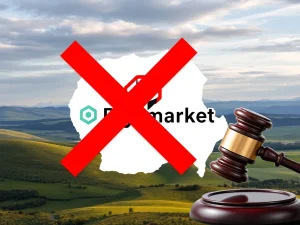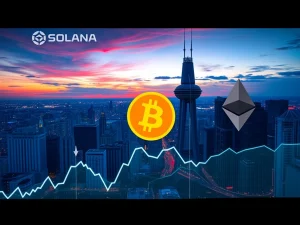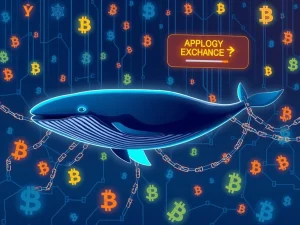Shocking Solana Price Drop: LIBRA Memecoin Scandal or Deeper Issues?

Solana (SOL), a cryptocurrency once hailed as a potential Ethereum killer, has recently experienced a notable price downturn, leaving investors and enthusiasts wondering what’s truly happening. While headlines might point fingers at the recent LIBRA memecoin scandal as the primary culprit, the reality is far more nuanced. Is the memecoin frenzy just a scapegoat, masking more fundamental challenges facing the Solana network? Let’s dive deep to uncover the real reasons behind Solana’s price woes and what the future might hold for this popular altcoin.
Is the LIBRA Memecoin Scandal Really Tanking Solana’s Price?
The crypto world is no stranger to drama, and the recent LIBRA memecoin episode certainly added fuel to the fire. News of insider dealings and potential market manipulation within the LIBRA project has undoubtedly cast a shadow over the Solana ecosystem, where the memecoin was launched. The negative publicity and erosion of trust can impact investor sentiment, leading to sell-offs and price depreciation. However, attributing Solana’s entire price decline solely to this scandal would be an oversimplification. While the LIBRA situation hasn’t helped Solana’s image, especially in terms of attracting new users and projects, it’s crucial to look beyond the headlines to understand the broader market dynamics at play.
Decoding the Solana Price Drop: Beyond the Memecoin Hype
To truly grasp why the Solana price is down, we need to examine key onchain metrics and broader market trends. Several factors are contributing to the current pressure on SOL, and understanding these is vital for any investor considering Solana’s future.
1. The Chilling Decline in Solana Onchain Activity
One of the most telling indicators of a blockchain’s health is its onchain activity. This includes the number of transactions, active users, and overall network utilization. Unfortunately, Solana has been witnessing a noticeable drop in its onchain activity. This decline suggests reduced user engagement and potentially less demand for transacting on the Solana network. When fewer people are using the blockchain, it naturally impacts the demand for its native token, SOL, leading to downward price pressure.
Factors contributing to reduced onchain activity might include:
- Broader Market Sentiment: The overall cryptocurrency market has experienced periods of correction and uncertainty, leading to reduced activity across many blockchains, not just Solana.
- Competition from other Blockchains: The blockchain space is incredibly competitive. Emerging layer-1 solutions and established players like Ethereum are constantly vying for users and developers. Shifts in user preference can impact Solana’s activity.
- Decline in DeFi Interest: Decentralized Finance (DeFi) applications are a major driver of onchain activity. If there’s a general cooling off in DeFi interest or if users are migrating to other platforms, Solana’s onchain activity could suffer.
2. DApps TVL Taking a Tumble: A Sign of Weakening Ecosystem?
Total Value Locked (TVL) in Decentralized Applications (DApps) is another crucial metric. It represents the total value of assets deposited in smart contracts on a blockchain’s DeFi ecosystem. A declining DApps TVL on Solana indicates that less capital is being utilized within its DeFi space. This can be interpreted as a lack of confidence in Solana-based DApps or a migration of liquidity to other platforms. A lower TVL often correlates with a weaker ecosystem and can negatively impact the SOL price drop.
Why is Solana’s DApps TVL decreasing?
- Security Concerns: Past network outages and security vulnerabilities within the Solana ecosystem might have eroded trust, leading users to withdraw their assets.
- Yield Farming Opportunities Elsewhere: The DeFi landscape is constantly evolving. More attractive yield farming opportunities might emerge on other blockchains, drawing liquidity away from Solana.
- Project Failures or Exploits: Negative events within specific Solana-based DApps, such as exploits or project failures, can scare away users and reduce overall TVL.
3. The Looming Shadow of Solana Token Unlocks
Token unlocks are a significant factor that can influence cryptocurrency prices. Solana, like many blockchain projects, has a schedule for unlocking previously restricted tokens. As more SOL tokens become available in the market, it can increase the circulating supply. If demand doesn’t keep pace with the increased supply, it can lead to inflationary pressure and a decrease in the Solana price. The anticipation of upcoming Solana token unlocks is likely contributing to the current bearish sentiment.
Understanding Solana’s Token Unlock Schedule:
- Vesting Schedules: Many early investors, team members, and advisors receive tokens with vesting schedules. These schedules release tokens over time, preventing immediate dumping and promoting long-term alignment.
- Market Impact: Large token unlocks are often viewed with caution by the market, as there’s always a risk that the newly unlocked tokens will be sold, increasing supply and potentially depressing prices.
- Transparency is Key: Solana’s token unlock schedule is publicly available, allowing investors to anticipate and factor these events into their investment decisions.
Solana’s Strengths: Why it’s Not All Doom and Gloom
Despite the current challenges, it’s crucial to remember Solana’s inherent strengths. Solana boasts impressive transaction speeds and lower fees compared to many other blockchains. Its technological capabilities remain a significant advantage. The Solana ecosystem continues to attract developers and projects, and innovation is still happening within its network. While the current market conditions are testing Solana, its underlying technology and community support provide a foundation for potential recovery.
Solana’s Key Advantages:
- High Throughput: Solana’s architecture is designed for high transaction speeds, making it suitable for applications requiring fast and efficient processing.
- Low Fees: Transaction fees on Solana are generally lower than on blockchains like Ethereum, making it more accessible for users.
- Growing Ecosystem: Despite recent setbacks, the Solana ecosystem is still expanding, with new projects and applications being developed.
- Strong Community: Solana has a vibrant and active community of developers, users, and supporters who are committed to its long-term success.
Navigating the Solana Situation: Actionable Insights for Investors
So, what should investors do amidst this Solana price volatility? Here are some actionable insights:
- Do Your Own Research (DYOR): Don’t rely solely on headlines or social media hype. Dive deep into Solana’s onchain metrics, project developments, and tokenomics.
- Assess Your Risk Tolerance: Cryptocurrency investments are inherently risky. Understand your risk tolerance and invest accordingly.
- Diversify Your Portfolio: Don’t put all your eggs in one basket. Diversification can help mitigate risk.
- Stay Informed: Keep up-to-date with the latest news and developments in the Solana ecosystem and the broader crypto market.
- Long-Term Perspective: Consider your investment horizon. Short-term price fluctuations are common in crypto. Focus on the long-term potential of the technology and ecosystem.
Conclusion: Solana’s Future – Navigating the Storm
The Solana price drop is a result of a confluence of factors, with the LIBRA memecoin scandal acting more as a negative catalyst than the primary cause. Declining onchain activity, reduced DApps TVL, and looming token unlocks are all contributing to the current market pressure. However, Solana’s technological strengths, active community, and ongoing development efforts suggest that it’s too early to write it off. The path ahead may be bumpy, but for those with a long-term vision and a solid understanding of the underlying dynamics, Solana could still present compelling opportunities in the evolving cryptocurrency landscape. Investors should remain vigilant, conduct thorough research, and make informed decisions based on their individual risk profiles.









